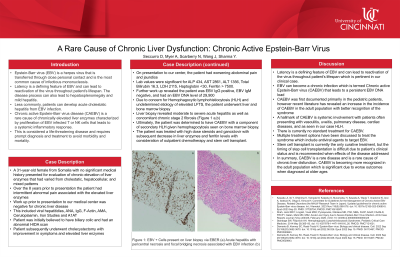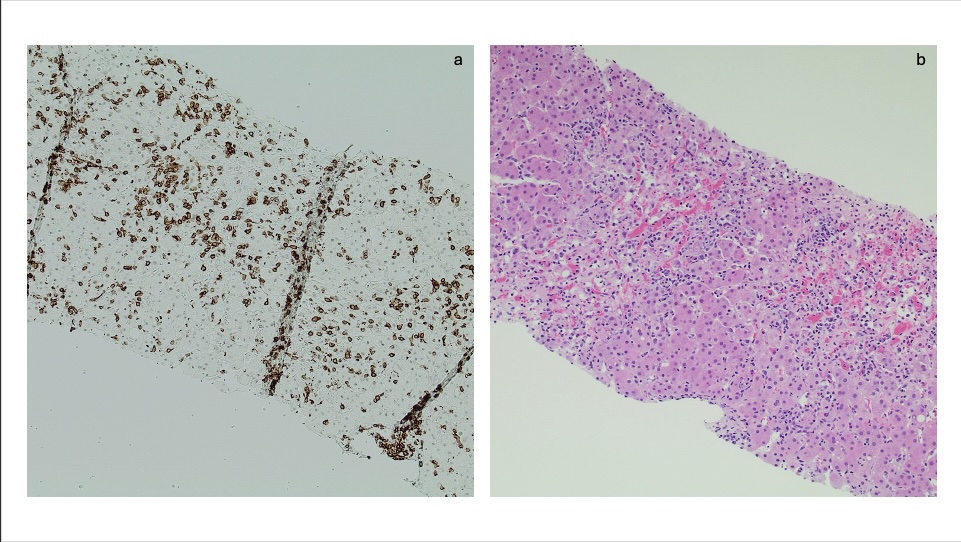Monday Poster Session
Category: Liver
P3047 - A Rare Cause of Chronic Liver Dysfunction: Chronic Active Epstein-Barr Virus
Monday, October 28, 2024
10:30 AM - 4:00 PM ET
Location: Exhibit Hall E

Has Audio

Drake Seccurro, MD
University of Cincinnati Medical Center
Cincinnati, OH
Presenting Author(s)
Drake Seccurro, MD1, Adam Myer, MD1, Jiang Wang, MD1, Nathaniel Scarberry, MD1, Yeshika Sharma, MD2
1University of Cincinnati Medical Center, Cincinnati, OH; 2University of Cincinnati, Cincinnati, OH
Introduction: Epstein-Barr virus (EBV) is a herpes virus that is transferred through close personal contact and is the most common cause of infectious mononucleosis. Latency is a defining feature of EBV and can lead to reactivation of the virus throughout patient’s lifespan. The disease process can also lead to hepatosplenomegaly and mild hepatitis. Less commonly, patients can develop acute cholestatic hepatitis from EBV infection. Chronic active Epstein-Barr virus disease (CAEBV) is a rare cause of chronically elevated liver enzymes characterized by proliferation of EBV infected T or NK cells that leads to a systemic inflammatory response. This is considered a life-threatening disease and requires prompt diagnosis and treatment to avoid morbidity and mortality.
Case Description/Methods: We present a 31-year-old female from Somalia with no significant medical history who presented for evaluation of chronic elevation of liver enzymes that had varied from a cholestatic, hepatocellular, and mixed patterns. The patient notably had intermittent abdominal pain and elevated liver enzymes over an 8-year time span. Workup prior to presentation included negative chronic liver disease workup including viral hepatitides, ANA, IgG, F-Actin, AMA, ceruloplasmin, iron studies and A1AT. Due to the unusual presentation, the patient was initially thought to have biliary colic given abnormal HIDA scan and underwent cholecystectomy with improvement in symptoms and liver enzymes. The patient then presented with worsening abdominal pain and jaundice. Lab values included ALP 434, AST 2861, ALT 1356, total bilirubin 16.3, LDH 2,115, haptoglobin < 30, ferritin >7,500. EBV IgG positive, IgM negative, and EBV DNA 29,900. Due to concern for secondary HLH and undetermined etiology of LFTs, the patient underwent liver biopsy which revealed moderate to severe acute hepatitis as well as concomitant chronic stage 2 fibrosis with numerous T-cells and EBV + Cells (Figure 1). Ultimately, the patient was determined to have CAEBV with a component of secondary HLH given hemophagocytosis seen on bone marrow biopsy. The patient was treated with high dose steroids and ganciclovir with subsequent decrease in liver enzymes and ferritin levels with consideration of stem cell transplant.
Discussion: CAEBV is a life-threatening disease and requires prompt diagnosis and treatment to avoid morbidity and mortality. Our case illustrates the importance of keeping a broad differential and recognizing CAEBV as a potential cause of chronically elevated LFTs.

Disclosures:
Drake Seccurro, MD1, Adam Myer, MD1, Jiang Wang, MD1, Nathaniel Scarberry, MD1, Yeshika Sharma, MD2. P3047 - A Rare Cause of Chronic Liver Dysfunction: Chronic Active Epstein-Barr Virus, ACG 2024 Annual Scientific Meeting Abstracts. Philadelphia, PA: American College of Gastroenterology.
1University of Cincinnati Medical Center, Cincinnati, OH; 2University of Cincinnati, Cincinnati, OH
Introduction: Epstein-Barr virus (EBV) is a herpes virus that is transferred through close personal contact and is the most common cause of infectious mononucleosis. Latency is a defining feature of EBV and can lead to reactivation of the virus throughout patient’s lifespan. The disease process can also lead to hepatosplenomegaly and mild hepatitis. Less commonly, patients can develop acute cholestatic hepatitis from EBV infection. Chronic active Epstein-Barr virus disease (CAEBV) is a rare cause of chronically elevated liver enzymes characterized by proliferation of EBV infected T or NK cells that leads to a systemic inflammatory response. This is considered a life-threatening disease and requires prompt diagnosis and treatment to avoid morbidity and mortality.
Case Description/Methods: We present a 31-year-old female from Somalia with no significant medical history who presented for evaluation of chronic elevation of liver enzymes that had varied from a cholestatic, hepatocellular, and mixed patterns. The patient notably had intermittent abdominal pain and elevated liver enzymes over an 8-year time span. Workup prior to presentation included negative chronic liver disease workup including viral hepatitides, ANA, IgG, F-Actin, AMA, ceruloplasmin, iron studies and A1AT. Due to the unusual presentation, the patient was initially thought to have biliary colic given abnormal HIDA scan and underwent cholecystectomy with improvement in symptoms and liver enzymes. The patient then presented with worsening abdominal pain and jaundice. Lab values included ALP 434, AST 2861, ALT 1356, total bilirubin 16.3, LDH 2,115, haptoglobin < 30, ferritin >7,500. EBV IgG positive, IgM negative, and EBV DNA 29,900. Due to concern for secondary HLH and undetermined etiology of LFTs, the patient underwent liver biopsy which revealed moderate to severe acute hepatitis as well as concomitant chronic stage 2 fibrosis with numerous T-cells and EBV + Cells (Figure 1). Ultimately, the patient was determined to have CAEBV with a component of secondary HLH given hemophagocytosis seen on bone marrow biopsy. The patient was treated with high dose steroids and ganciclovir with subsequent decrease in liver enzymes and ferritin levels with consideration of stem cell transplant.
Discussion: CAEBV is a life-threatening disease and requires prompt diagnosis and treatment to avoid morbidity and mortality. Our case illustrates the importance of keeping a broad differential and recognizing CAEBV as a potential cause of chronically elevated LFTs.

Figure: Figure 1: EBV + Cells present on liver biopsy via EBER (a)
Acute hepatitis with pericentral necrosis and focal bridging necrosis associated with EBV infection (b).
Acute hepatitis with pericentral necrosis and focal bridging necrosis associated with EBV infection (b).
Disclosures:
Drake Seccurro indicated no relevant financial relationships.
Adam Myer indicated no relevant financial relationships.
Jiang Wang indicated no relevant financial relationships.
Nathaniel Scarberry indicated no relevant financial relationships.
Yeshika Sharma: Intercept Pharmaceuticals – Speakers Bureau.
Drake Seccurro, MD1, Adam Myer, MD1, Jiang Wang, MD1, Nathaniel Scarberry, MD1, Yeshika Sharma, MD2. P3047 - A Rare Cause of Chronic Liver Dysfunction: Chronic Active Epstein-Barr Virus, ACG 2024 Annual Scientific Meeting Abstracts. Philadelphia, PA: American College of Gastroenterology.
